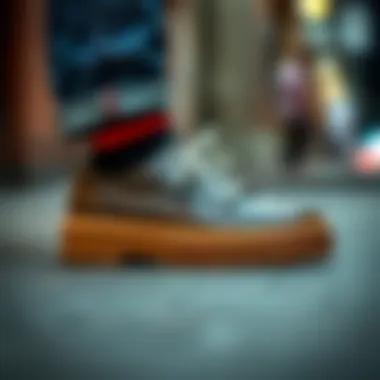Exploring Men's Vulcanized Shoes: History and Impact


Intro
The history of men's vulcanized shoes stretches beyond mere footwear; it’s a saga woven into the fabric of style, utility, and culture. This unique shoe style has evolved over time, from humble beginnings associated with labor and leisure to a staple in the modern man's wardrobe. As we step into this exploration, it is vital to understand these shoes' multifaceted nature—what they're made of, how they influence fashion, and the subtle statements they can make.
Vulcanized shoes are distinguished by their method of construction, where rubber is treated with heat and sulfur to enhance its durability and flexibility. This process gives the shoes properties that withstand both the elements and the test of time. The result? A feel-good factor that resonates well with wearers nowadays as they navigate through various occasions, be it a casual outing or a more formal affair. More than just another brand on the rack, these shoes carry an ethos that appeals to both the practical and the aesthetic mind.
In this article, we will dissect the journey of men’s vulcanized shoes, setting the stage for a comprehensive overview that includes their historical significance, design elements, and their undeniable impact on today’s fashion landscape. Let’s lace up and delve deep into the various aspects that make vulcanized shoes an enduring choice for style aficionados and everyday wearers alike.
Understanding Vulcanization
Vulcanization is not merely a term known to shoe aficionados; it's the backbone of what gives men's vulcanized shoes their unique characteristics. By grasping the mechanics and principles behind this process, one can appreciate not just the construction of these shoes but also their relevance in today’s fashion landscape. The importance lies in how vulcanization enhances durability, comfort, and versatility—attributes that are ever-important in contemporary footwear.
The vulcanization process involves treating rubber with sulfur, resulting in a stronger material that withstands wear and tear. It can be likened to the difference between a raw, fragile egg and a hard-boiled one—the latter is far more resilient. This gives shoes made by the vulcanization method a distinct edge: they have longer lifespans and superior performance, whether one is jogging on a trail or navigating through city streets.
Beyond physicality, vulcanized shoes have also cemented their place in modern culture. The process has impacted numerous areas, particularly design and aesthetics. Sneaker culture, skateboarding, and street fashion owe a chunk of their identity to this innovation. In essence, understanding vulcanization provides a lens through which one can view the evolution of footwear fashion.
The Process of Vulcanization
At the core of vulcanization is a chemical reaction that alters the properties of rubber. It begins with mixing raw rubber with sulfur and other catalysts, followed by heat application to facilitate cross-linking of the polymer molecules. This creates a three-dimensional network, enhancing the rubber’s resilience and elasticity. Think of it as giving the rubber a robust structure, akin to building a fortress where each wall reinforces the others.
Key Steps in the Process of Vulcanization:
- Preparation of the Rubber Mixture: Rubber is blended with sulfur, accelerators, and fillers.
- Molding the Material: The mixture is placed in a mold that forms it into the desired shape, typically a shoe.
- Heating: It's then subjected to heat, commonly in the range of 140-160°C (284-320°F), which triggers the vulcanization reaction.
- Cooling and Finishing: After sufficient time, the mold is cooled, and the vulcanized shoe takes its final form that will eventually step onto the fashion stage.
The heat is essential, as it instigates the chemical bonds between sulfur atoms and rubber chains. This results in a product that is not only tougher but also more flexible, making it ideal for various applications beyond shoes, including tires and industrial components.
Historical Development of Vulcanization
The concept traces back to 1839, when Charles Goodyear stumbled upon the process accidentally. Goodyear was experimenting with rubber and sulfur when he left a mixture near a stove, resulting in a far more durable material than anything seen before. This serendipitous moment set the wheels in motion for what would become a revolution in materials science.
Over the decades, various improvements and innovations followed. The ability to mass-produce vulcanized rubber quickly saw its use in everything from footwear to machinery components. By the late 19th and early 20th centuries, many shoe manufacturers embraced vulcanization, leading to the creation of iconic models that are still celebrated today.
In the context of men's fashion, this historical evolution highlights how practical innovations can transcend utilitarian needs, morphing into style statements. With each new era, the aesthetic appeal of vulcanized shoes adapted, giving rise to various trends that reflect the societal shifts of their time.
The journey of vulcanization is not just about chemistry; it's about crafting a legacy—one that has carved a niche in the footwear industry and cultural zeitgeist. As modern consumers appreciate both style and substance, the narrative of vulcanized shoes resonates now more than ever.
The Construction of Vulcanized Shoes
The construction of vulcanized shoes holds intricate significance in both the practicality and aesthetics of footwear. This section will delve into the materials that form the backbone of these designs, the distinctive features that set them apart, and the manufacturing processes that bring them to life.
Materials Used in Vulcanized Shoes
Vulcanized shoes owe their durability to the materials from which they are crafted. At the heart of these shoes is rubber, often sourced from rubber trees, which can be further modified for various needs by mixing it with other materials. The upper part of the shoe, typically made from canvas or leather, plays a crucial role in the overall function.
- Rubber: This flexible material, known for shock absorption, forms the sole, allowing for comfort during prolonged wear. Its resilience is unmatched, especially when subjected to various terrains.
- Canvas: A popular choice for the upper, canvas adds breathability and lightweight qualities, essential for comfort. It can be easily dyed, allowing for diverse styles.
- Leather: While not as common as canvas, leather is sometimes used for a more polished look. It provides a toughness that complements the rubber sole.
- Distinctive Additives: Manufacturers often incorporate additives into the rubber composition to enhance characteristics such as UV resistance or to improve longevity.
These materials combined yield a shoe that not only stands the test of time but is also fashionable.
Key Design Features


The design features of vulcanized shoes distinguish them from traditional footwear. Several essential aspects accomplish this uniqueness.
- Low-Profile Design: Often, vulcanized shoes have a streamlined silhouette that complements various styles, making them a staple in both casual and semi-formal attire.
- Textured Soles: The soles are often designed with unique patterns that increase traction. This is particularly beneficial for urban settings where slipping can be an issue.
- Reinforced Stitching: To ensure longevity, many brands reinforce stitching around the upper and sole junction. This adds not just to durability but also enhances visual interest.
- Lace Systems: The lacing mechanism often features circular or oval-shaped eyelets, which provide both strength and style.
"The beauty of vulcanized shoes lies not only in their looks but in their ability to be functional and stylish, a rare combination in the world of footwear."
Manufacturing Techniques
The manufacturing process of vulcanized shoes is a blend of traditional craftsmanship and modern technology. Understanding this process sheds light on how quality is maintained.
- Preparation of Components: The rubber is prepared through a process involving heat and sulfur, known as vulcanization, which binds rubber molecules together, enhancing durability.
- Cutting and Shaping: The upper materials are cut to size before they are assembled. Precision in this step is critical to ensure a perfect fit.
- Assembly Process: Components are then sewn together, with exacting attention paid to structural integrity and aesthetics. This stage often involves skilled artisans who are familiar with decades of craftsmanship.
- Vulcanization: The assembled shoe goes through the final vulcanization process where it is heated. This provides the rubber with its signature durability and flexibility. Each shoe undergoes quality checks to ensure it meets standards.
- Finishing Touches: Finally, each shoe receives finishing touches, including polishing (if made of leather), adding brand labels, and inspecting for any flaws.
Through these meticulous steps, vulcanized shoes are made, fusing style with functionality in every pair, ensuring they are ready for consumers who value both elegance and endurance.
Men's Vulcanized Shoes in Fashion
Vulcanized shoes have carved out a niche that resonates beyond mere function. Their place in fashion today is significant, blending practicality with style. The appeal lies not just in the durability that vulcanization affords, but also in the rich tapestry of designs and cultural relevance they bring to the table. Understanding the evolution and current state of men’s vulcanized shoes offers insights into why they are a pivotal choice for many fashion-forward individuals.
From skateboarding to street style, the versatility allowed by these shoes makes them a staple in men’s wardrobes.
Trends in Current Footwear Styles
In the realm of footwear, trends are continually reshaping the landscape, and men’s vulcanized shoes are no exception. Varying from minimalist aesthetics to bold statements, the current trends have something for everyone. Common styles include:
- High-tops: These shoes come up past the ankle for extra support and are favored for their retro vibe.
- Low-tops: Perfect for casual outings, these work well with shorts, jeans, or even dressier trousers.
- Chunky soles: A throwback to the 90s, chunky soles provide both comfort and a trendy edge.
As fashion continues to embrace comfort, expect to see more styles that complement active lifestyles without sacrificing aesthetic appeal.
Influence of Streetwear Culture
Streetwear culture has played a pivotal role in popularizing men’s vulcanized shoes. This fashion movement, rich in a blend of casual wear and high fashion elements, has integrated these shoes into its fabric seamlessly. Here’s how:
"Streetwear is where everyday life meets high fashion, and vulcanized shoes are there at the confluence."
- Sneaker collaborations: Brands often collaborate with artists and designers, producing limited editions of vulcanized shoes. This creates a buzz that elevates the shoe from basic to must-have.
- Fashion icons: Many influencers and celebrities incorporate these shoes into their signature styles, further propelling interest. The likes of Kanye West and Pharrell Williams have extensively embraced vulcanized shoes, showcasing their adaptability.
- Graphic tees and layers: Vulcanized shoes often find their home alongside relaxed fits, oversized clothing, and bold graphics, capturing attention while maintaining comfort.
In essence, the synergy between streetwear and men’s vulcanized shoes offers a vibrant narrative that speaks both to the present and the future of fashion.
Advantages of Vulcanized Shoes
In today’s fashion landscape, the significance of vulcanized shoes cannot be overstated. These shoes offer a unique blend of durability, comfort, and versatility that appeals to a broad audience. Men’s vulcanized shoes have carved out a reputable niche, making them essential for various lifestyles, whether one is gearing up for a casual day out or prepping for a more rugged adventure. Understanding the advantages can assist in making an informed choice, ensuring that one embraces both style and function.
Durability and Longevity
When it comes to footwear, durability is king. Vulcanized shoes are known for their tough construction as they undergo a specialized process that transforms rubber into an incredibly resilient material. Unlike conventional shoes, which may crumble under consistent wear, vulcanized shoes boast a lifespan that can extend for years, making them a wise investment.
- Resistant to Damage: The infusion of heat during vulcanization creates strong bonds within the rubber, ensuring that it can withstand abrasions, impacts, and environmental wear and tear.
- Low Maintenance Needs: These shoes require less upkeep due to their robust nature, helping to keep costs down in the long run.
In short, if you’re after footwear that can endure the test of time, vulcanized options rise head and shoulders above the rest.
Comfort and Fit


Comfort isn’t just a bonus; it’s a necessity in today’s fast-paced world. Vulcanized shoes are designed with ergonomic features that cater to the natural shape of the foot. This attention to comfort is particularly relevant in an era where many spend hours on their feet.
- Soft Footbeds: These shoes often come with cushioned insoles that absorb impact while walking or standing.
- Breathable Materials: Improved designs include breathable uppers, allowing for air circulation, thus keeping feet dry and comfortable.
- Natural Movement: Many styles allow for flexible movements which promote a more natural gait, minimizing fatigue as the day wears on.
By combining form and function, vulcanized shoes provide a seamless fit that enhances the overall wearing experience.
Adaptability to Various Styles
One of the standout qualities of vulcanized shoes is their remarkable adaptability. They fit into various wardrobe pieces effortlessly, from laid-back streetwear to more polished casual ensembles. This is what makes them a staple in many men’s closets.
- Versatile Designs: Whether one is drawn to classic sneakers or prefers a more contemporary silhouette, the choices are plentiful.
- Seasonal Flexibility: Vulcanized shoes can be worn throughout different seasons, pairing well with shorts in summer or jeans in cooler months.
- Color and Pattern Variety: With a spectrum of colors and patterns available, there's a pair for every personal style, from bold graphics to understated hues.
Ultimately, the adaptability of vulcanized shoes means that one can easily transition from day to night, making them an irreplaceable part of any modern wardrobe.
Vulcanized shoes are not merely utilitarian; they embody a blend of practicality and personal expression that resonates with today's fashion-forward individuals.
These advantages highlight just why vulcanized shoes hold a significant place in both men’s fashion and practicality. As styles continue to sprawl, these shoes maintain their relevance, drawing in enthusiasts across various demographics.
Care and Maintenance of Vulcanized Shoes
Taking care of vulcanized shoes goes beyond just keeping them clean; it reflects a broader understanding of preserving style and functionality. Proper care ensures longevity, the aesthetic appeal of the shoes, and maximizes the investment made in quality footwear. For enthusiasts and professionals alike, neglecting maintenance can lead to premature wear and the shedding of value.
Cleaning Techniques
Cleaning vulcanized shoes requires a thoughtful approach, ensuring the materials remain intact while addressing stains and dirt build-up. Here are some effective cleaning methods:
- Brush Away Debris: Begin with a soft-bristle brush to remove dirt and dust from the surface. Gently brush in a circular motion to avoid damaging the fabric or rubber.
- Mild Soap Solution: Mix warm water with a few drops of mild detergent. Dampen a cloth in this solution, wring it out, and then wipe down your shoes. Avoid soaking them, as excess water can weaken the vulcanization process.
- Stubborn Stains: For tougher spots, consider using a soft eraser or a specialized rubber cleaner. Apply lightly to the affected area. Always test the cleaner on a small, inconspicuous section first.
- Drying: Allow your shoes to air dry naturally. Avoid direct sunlight or heat sources, as they can warp the material and alter the shape of your shoes.
"Cleansing your vulcanized shoes is not merely a chore; it's an act of respect to the craftsmanship involved."
Storage Tips
How you store your shoes can significantly impact their lifespan. Here’s how to keep your vulcanized footwear in tip-top condition:
- Avoid Crumpling: Always store shoes in their original box or a dedicated shoe bag to maintain their shape. This prevents creasing and flattening of the footbed.
- Keep Dry: Ensure the storage area is dry and well-ventilated. Humidity can lead to mold growth and material degradation over time.
- Use Shoe Trees: Consider using cedar shoe trees, which help absorb moisture and retain shape. They also have the added benefit of imparting a pleasant smell.
- Rotate Your Shoes: Don’t wear the same pair continuously. Rotating pairs allows each to rest, extending their usable life and ensuring freshness.
By taking these care and maintenance steps, wearing vulcanized shoes can continue to be a rewarding experience, bridging the past with contemporary style while standing the test of time.
Common Brands of Vulcanized Shoes
Vulcanized shoes have carved out a significant niche in the footwear market, and this is largely attributable to the prominent brands that have championed their design and construction. These common players not only shape the styles and trends but also influence consumer choices globally. Understanding these brands and their offerings is essential for anyone who wishes to navigate the world of vulcanized shoes and appreciate their impact on contemporary fashion.
Profiles of Leading Brands
Several brands stand out in the vulcanized shoe arena, each bringing unique offerings that cater to different tastes and needs. Some of the most notable are:
- Converse: Best known for its iconic Chuck Taylor All-Stars, Converse has solidified its place in both casual and high-fashion circles. The vulcanized rubber sole is a hallmark of its durable design, with a silhouette that appeals to diverse audiences.
- Vans: With its roots firmly planted in skate culture, Vans offers a myriad of styles, from classic slip-ons to high-tops. Their emphasis on comfort and functionality makes them a favorite among adventurers and streetwear enthusiasts alike.
- Superga: An Italian brand renowned for its classic canvas sneakers, Superga combines elegance with simplicity. Their designs are perfect for those looking to add a touch of European chic to their footwear wardrobe.
- Keds: Keds offers a selection that is notably feminine yet versatile, with many designs featuring the classic vulcanized construction that ensures longevity and comfort.
Each of these brands has its distinct flavor, often embodying the cultural context from which they arise. For instance, while Vans might hold sway in skate parks, Converse resonates in art and music spaces.


Comparative Analysis of Styles
When it comes down to choosing a pair of vulcanized shoes, understanding the nuances between different brands is vital. Here are some dimensions to consider:
- Design Aesthetics: Converse's construction is perpetually paired with a sportier vibe, often featuring bold colors and patterns, while Superga might lean towards a more understated, clean design. This contrast can influence how a pair of shoes complements an outfit.
- Functionality and Comfort: Vans shoes, thanks to their skate heritage, are designed with practicality in mind. With extra padding and a robust grip, they are ideal for those who often find themselves on the move. In contrast, Keds provides a simpler, everyday comfort that may be best suited for casual outings.
- Cultural Impact: Each brand carries an aura shaped by its historical context. Converse, for instance, has been a staple in rock fashion, while Superga has been embraced by the elegant crowd of Italian fashionistas. Understanding this cultural significance can deepen one's appreciation of their choice.
"Footwear is not just an accessory; it defines a style and reflects personality."
Choosing vulcanized shoes involves more than just picking a pair off the shelf. It’s about aligning one’s lifestyle and fashion sensibilities with the right brand. Thus, whether you’re swayed by Converse’s long-standing legacy or drawn to the modern flair of Superga, knowing the brand’s context enriches the decision-making process.
Vulcanized Shoes Across Different Cultures
Vulcanized shoes carry unique narratives, weaving through the fabric of various cultures worldwide. Each culture brings its own touch to this footwear style, showcasing not just aesthetic appeal but also practical functionality. In this section, we'll explore the cultural significance and global variations surrounding vulcanized shoes, thereby highlighting their role in fashion and daily life.
Cultural Significance in Footwear
In many societies, shoes are not merely items of clothing but rather symbols of identity and culture. Vulcanized shoes exemplify this, as they have transcended their original purpose to become cultural icons.
- For example, in the United States, brands like Converse and Vans have embedded themselves deeply in the youth culture, representing both casual style and extracurricular activities. Their designs, often characterized by bold graphics and unique silhouettes, reflect the vibrant tapestry of American street fashion.
- Similarly, in the youth-focused settings of Japan, vulcanized shoes have achieved a status that resonates with the East Asian culture of value toward craftsmanship and individual expression.
- In contrast, markets in Resource-rich countries see vulcanized shoes made with local materials, often influenced by traditional designs that interweave cultural narratives, adding depth to the footwear beyond its functional role.
"Footwear has long been a reflection of societal values, telling stories that words cannot."
Beyond mere trends, vulcanized shoes engage in conversations about class, economic conditions, and global trade. Many cultures have embraced these shoes due to their affordability and versatility, allowing people to express their identity with what they wear on their feet.
Global Variations and Styles
Vulcanized shoes are incredibly diverse, adapting to fit various cultural contexts. This global take on a seemingly simple footwear design elevates it to an international phenomenon.
- In Europe, particularly in Italy, vulcanized shoes often feature premium materials, aligning luxury with tradition. Italian brands add a layer of sophistication, incorporating artisanal craftsmanship, which resonates with their fashion-forward outlook.
- Moving eastward to South Asia, particularly in India, vulcanized shoes morph into vibrant colors and patterns, reflecting the local attire and festivities. These shoes often use local textiles, illustrating a blend of Western and indigenous elements that cater to a different market sensibility.
- In the African continent, regions may adopt vulcanized shoes rooted in practicality, using durable materials suitable for varied terrains, showcasing the importance of function over form while still embracing global trends.
By examining these multifaceted styles, one can appreciate how vulcanized shoes are not just a global trend but a canvas on which cultures express themselves uniquely. Their design evolves continually, melding history, environment, and societal needs into a singular piece of footwear.
In summary, vulcanized shoes encapsulate a rich cultural tapestry that reflects individuality across different societies. As they maintain their practicality and style, their significance continues to deepen, ensuring their place in footwear history well into the future.
Finale: The Future of Men's Vulcanized Shoes
As we look ahead, the landscape of men’s vulcanized shoes is marked by innovation and an increasing emphasis on sustainability. The footwear industry, and particularly the niche of vulcanized shoes, is evolving to meet the demands of a more conscious consumer. This adaptation is very relevant, as the appreciation of style now extends beyond aesthetics to encompass ethical production practices and environmental responsibility.
"Fashion is what you’re offered four times a year. And style is what you pick out of that fashion."
-Laurence Benaïm
One significant trend is the focus on sustainable innovations in production. As manufacturers seek to lessen their environmental footprint, there’s a growing trend towards utilizing recycled rubber and eco-friendly materials. This shift not only caters to the environmental concerns of consumers but also enhances the overall appeal of vulcanized shoes—making them a suitable choice for eco-conscious fashionistas. For instance, brands like Vans are increasingly incorporating organic cotton and recycled materials into their footwear designs. This not only signifies a broader commitment to sustainability but also enriches the story behind the shoes.
Sustainable Innovations in Production
Sustainable production methods are becoming essential in the footwear industry. Companies are exploring alternative sources for their materials as well as changing manufacturing processes to reduce waste and pollution. As an example, some brands have introduced water-based adhesives that eliminate the need for harmful chemicals. Brands are also focusing on the longevity of their products, crafting shoes that last longer thereby reducing the frequency of replacements and minimizing waste.
Some of the sustainable innovations include:
- Use of recycled materials: Utilizing rubber scraps and old shoes in new designs.
- Bio-based materials: Adoption of materials derived from renewable resources, like corn or bamboo, to create shoe components.
- Carbon-neutral initiatives: Many companies aim to achieve carbon neutrality by implementing energy-efficient practices throughout the production chain.
Evolving Trends in Consumer Preferences
Consumer preferences in the footwear market are shifting towards more personalized and unique styles. Men are increasingly gravitating towards shoes that not only exude individual flair but also adhere to higher ethical standards.
Today’s shoppers often consider the story behind their footwear. They want to know where the materials come from and how the shoe was made. This wave of consumer awareness is steering brands to focus on transparency.
Additionally, the influence of digital technology can't be overstated. The rise of direct-to-consumer brands allows men to tailor their footwear choices according to personal tastes. Customizable options allow consumers to choose colors, styles, and materials, creating a direct connection between identity and footwear. This personalization imbues each pair with a certain significance that extends beyond mere functionality.







